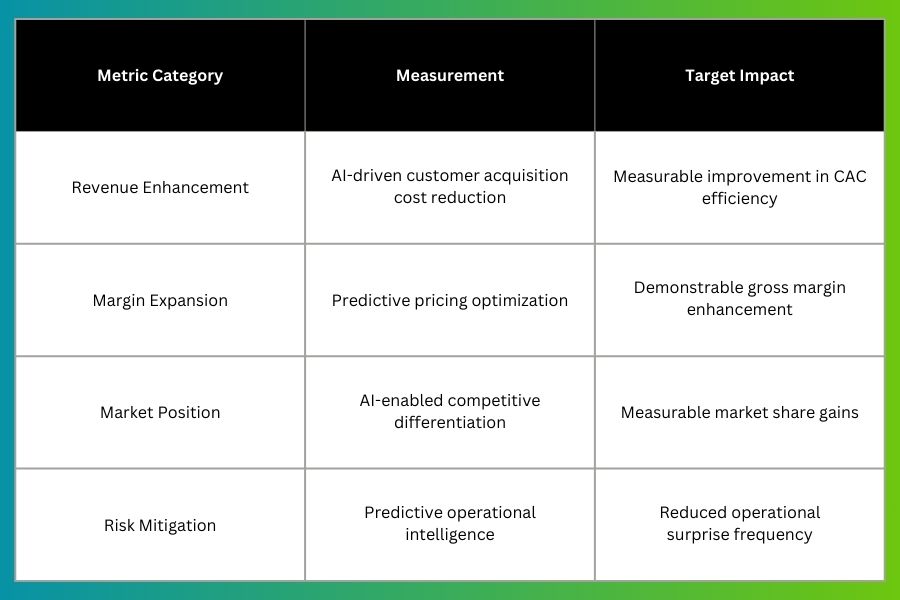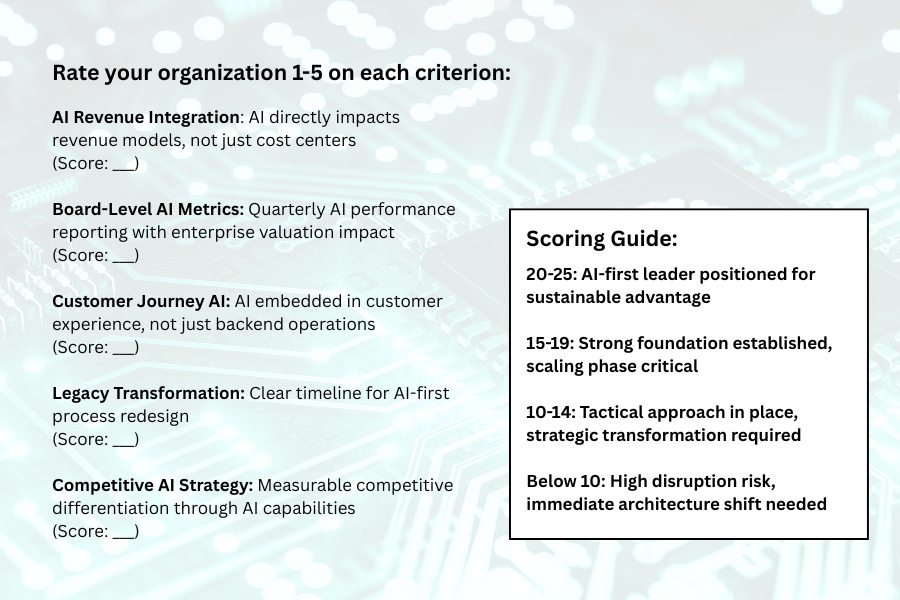How CEOs Can Move from AI Adoption to AI Architecture:
The 90-Day Strategic Framework
What Does AI-First Architecture Really Mean for CEOs?
For years, CEOs have been told that AI is a tool, a shiny new asset to squeeze costs, automate workflows, and "improve efficiency." That mindset isn't just outdated. It's the fastest path to irrelevance.
AI is not a side project or departmental initiative. It's the architect of the next generation of business models. According to recent McKinsey research, companies implementing AI at the architectural level see 23% higher revenue growth compared to those using AI tactically. The difference between AI adoption and AI architecture isn't semantic, it's existential.
Why Can't CEOs Delegate AI Strategy to Chief Digital Officers?
Let's be blunt: You cannot delegate this to a Chief Digital Officer. AI is not a function. It is the future structure of your enterprise.
When electricity arrived in factories during the early 20th century, most leaders simply swapped steam engines for electric motors but kept their factories organized the same way. Productivity gains were minimal. It wasn't until Henry Ford redesigned the factory itself, introducing the moving assembly line, that electricity became the force multiplier it was destined to be.
Today, AI stands at the same crossroads. Leaders who "plug it in" to existing structures will see short-term cost savings. Leaders who redesign the structure of their business around it will own the next decade.
The CEO's 90-Day AI Architecture Framework
Phase 1: Current State Analysis (Days 1-30)
Week 1-2: AI Readiness Audit
- Map current AI investments against revenue engines, pricing models, and product roadmaps
- Identify legacy processes vulnerable to AI disruption within your specific industry vertical
- Benchmark AI integration depth against top quartile competitors in your sector
Week 3-4: Value Creation Assessment
- Calculate potential ROI from predictive personalization versus reactive automation
- Analyze customer journey touchpoints for AI integration opportunities
- Quantify the gap between current AI spending and enterprise valuation impact
Phase 2: Architecture Design (Days 31-60)
Week 5-6: Strategic Integration Blueprint
- Design board-presentable AI valuation models with specific KPIs
- Create cross-functional AI governance framework connecting CDO, CTO, and CEO priorities
- Establish pilot-to-scale methodology with measurable success criteria
Week 7-8: Operational Transformation Planning
- Build AI performance dashboards for board reporting and real-time decision-making
- Design change management protocols for AI-first process redesign
- Create competitive differentiation strategy based on AI capabilities
Phase 3: Implementation Launch (Days 61-90)
Week 9-10: Enterprise Integration Execution
- Launch initial AI architecture pilots in highest-impact revenue areas
- Implement real-time AI dashboards for CEO-level predictive decision-making
- Begin legacy process transformation using AI-first design principles
Week 11-12: Board and Stakeholder Alignment
- Present comprehensive AI valuation impact to board with specific metrics
- Establish ongoing AI performance review cycles and governance structures
- Create competitive positioning strategy highlighting AI-driven differentiation
How Do You Measure AI's Impact on Enterprise Valuation?
The most critical shift CEOs must make is from operational metrics to valuation metrics. Investors increasingly expect demonstrable AI impact on enterprise value, as AI integration becomes a standard evaluation criterion in due diligence processes.
Key AI Valuation Metrics for CEO Dashboards
What Specific Actions Should CEOs Take in the Next 90 Days?
Immediate CEO Imperatives:
- Mandate AI Architecture, Not Adoption
Set the organizational mandate that AI investments must demonstrate enterprise value creation, not just cost optimization
- Redesign Around Intelligence
Challenge every department to design processes around AI capabilities rather than bolting AI onto existing workflows
- Educate Your Board on AI Valuation
Present quarterly AI impact reports showing specific enterprise value creation, not just operational efficiency gains
- Destroy Legacy Before AI Destroys It
Proactively eliminate processes that AI will inevitably disrupt, controlling the transformation timeline
- Build Predictive Leadership Capabilities
Shift from reactive dashboard management to AI-enabled predictive decision-making for board-level strategy
Why This Transformation Matters Now
The clock is ticking. AI adoption curves are accelerating 3.2 times faster than previous technology waves, with enterprise integration timelines compressed from 7-10 years to 2-3 years. In converging markets where B2B and B2C models are collapsing into one another, AI serves as the connective tissue that determines who survives the turbulence.
Investors know it. Boards know it. Competitors know it. The only question is whether CEOs are willing to get uncomfortable enough to re-architect their businesses before it's too late.
Frequently Asked Questions: CEO AI Strategy
Q: How do I measure AI's impact on enterprise valuation?
A: Track AI-driven revenue enhancement, margin expansion, competitive differentiation, and risk mitigation using specific KPIs that correlate with enterprise value multiples in your sector.
Q: What's the difference between AI cost-optimization and AI-driven growth?
A: Cost optimization treats AI as an efficiency tool within existing processes. AI-driven growth redesigns business models around AI capabilities to create new value streams and competitive advantages.
Q: How do I build an AI-first culture without disrupting current operations?
A: Use the 90-day phased approach: analyze current state, design new architecture, then implement systematically while maintaining operational continuity through planned transition periods.
Q: What are the warning signs that my company is falling behind in AI adoption?
A: Key indicators include: AI treated as IT project rather than CEO mandate, pilots that never scale, no AI metrics in board reporting, and competitive advantages eroding without clear AI response strategy.
The 5-Minute AI Strategy Health Check
Where CEOs Re-Architect the Future
This uncomfortable but necessary transformation is exactly why we designed RevvedUP 2026 (March 23-24, The Vinoy Resort, St. Petersburg, FL) as a high-stakes strategy lab for CEOs under pressure to redefine growth in the AI era. Across two intensive days, leaders will pressure-test how AI moves from cost center to growth driver, with real case studies from peers who are already succeeding. From revenue engines to board expectations, from competitive positioning to enterprise valuation, RevvedUP 2026 is where CEOs and their C-Suite teams reset their playbook for the AI-first economy. Because in 2026, incremental change guarantees irrelevance. The only growth strategy left is intelligent reinvention.
--------------------------------------------------------------------------------------------------------
Coming Next in This Series:
"The CEO's AI Readiness Assessment: 25 Critical Questions Every Board Should Ask" – Get the comprehensive evaluation framework that turns board meetings from AI skepticism to strategic acceleration.
About the Author
Heather Holst-Knudsen is a distinguished figure and expert in the events, media, marketing and technology sectors. Using her extensive experience, she guides clients in adapting to structural economic and market changes, seizing the chance to innovate and evolve. She specializes in digital and data disruption and opportunity, exploring how these overarching factors can impact revenue growth, customer-centricity, operational efficiency, profit margins, and the overall valuation of companies in both public and private markets. Her journey began at her family business, Thomas Publishing Company, where she honed her skills. She further expanded her expertise by holding positions at early industry giants Miller Freeman, Reed Elsevier, and IDG. Returning to Thomas Publishing, Heather founded and spearheaded Manufacturing Enterprise Communications, an integrated media portfolio connecting buyers and sellers in the manufacturing and technology sectors. Starting in 2015 and spanning the next seven years, she leveraged her expertise as a revenue and business leader in various SaaS businesses, including Feathr, Gleanin, Brella and Edflex.
Heather is deeply passionate about digital innovation, data monetization, and AI and how these strategies fuel revenue growth, profitability, and company valuation. To serve and create value for clients in these areas, she launched H2K Labs, dedicated to generating and leveraging value through data for media, business information, events, and adjacent technology and service markets. 









